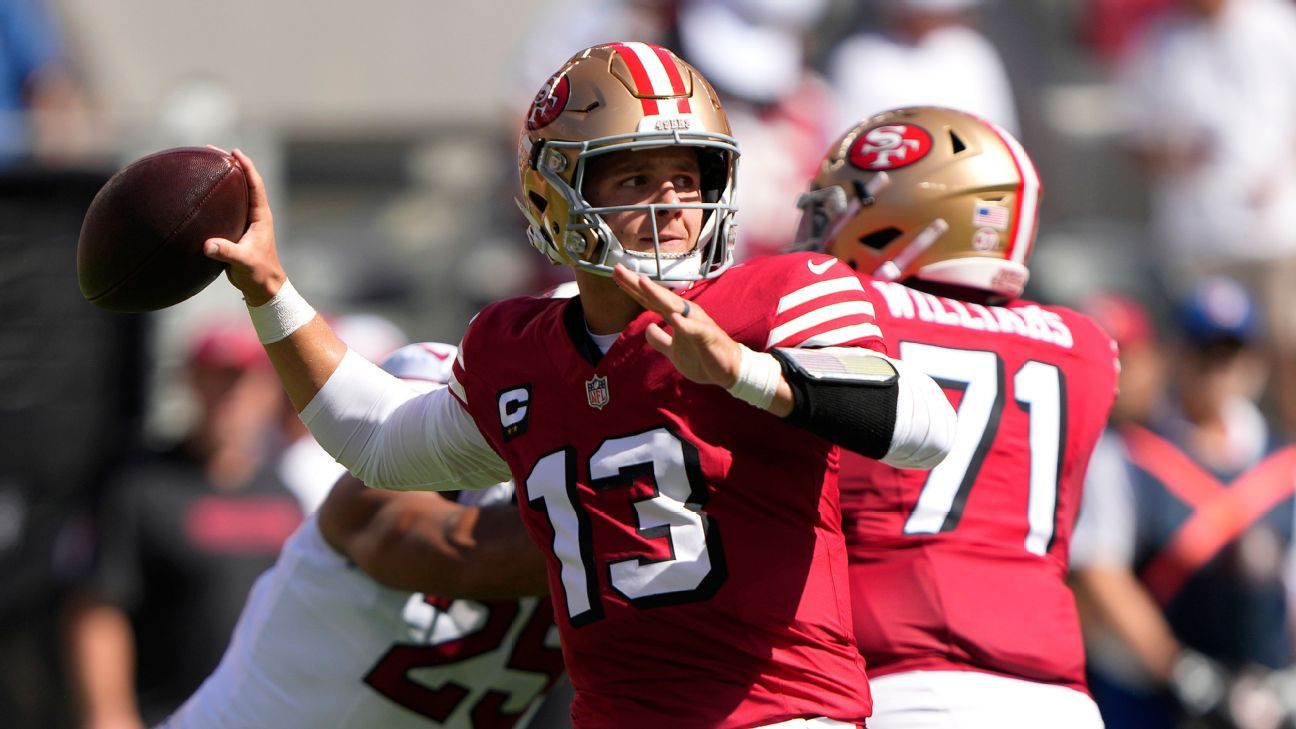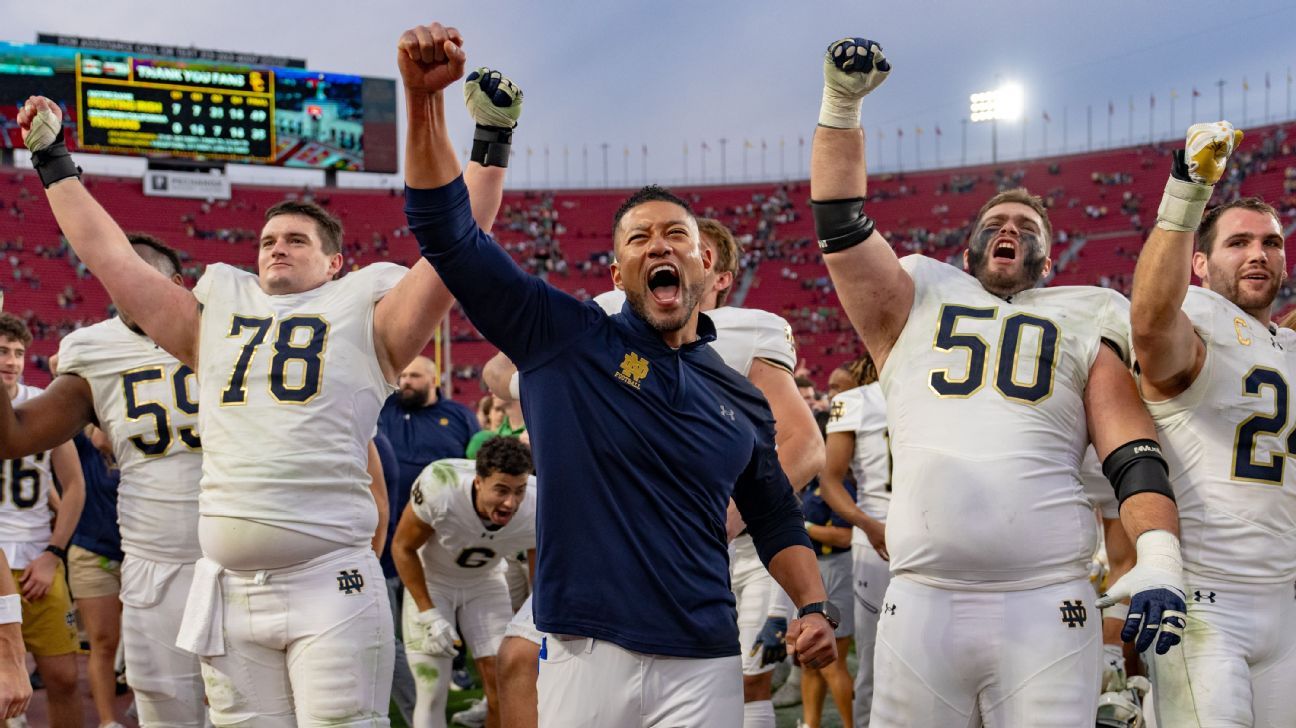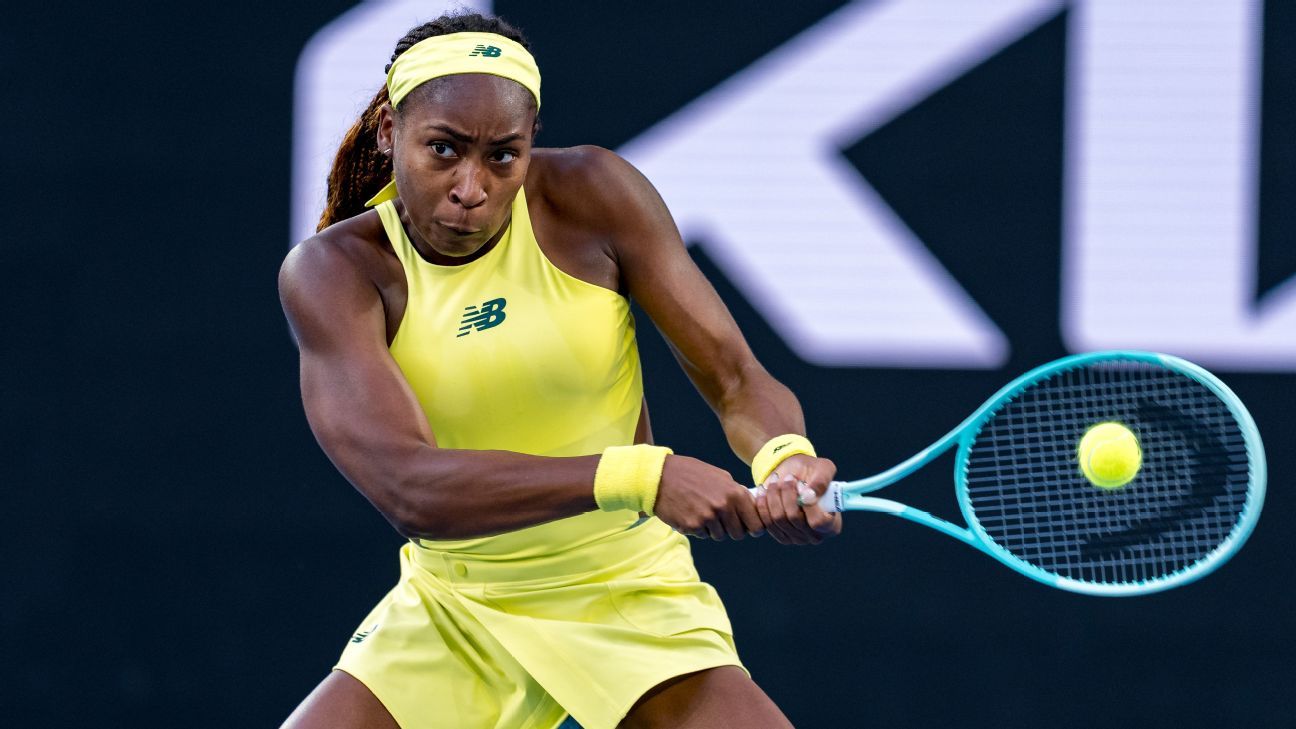SANTA CLARA, Calif. — In February, two days after the San Francisco 49ers fell short of winning a Super Bowl for the fourth time in five years, general manager John Lynch was asked what it would take to finally get over the hump.
Lynch responded not with a specific position that needed bolstering but with a more abstract concept: The 49ers needed “finishers in every area of the team.”
San Francisco needed to find the missing piece who could make the one tackle or catch the one pass that would swing the pendulum in its favor against teams, such as the Kansas City Chiefs, on stages as big as the Super Bowl.
But five games into the 2024 season, the Niners might not even have enough to overcome supposedly inferior NFC West division foes in the Los Angeles Rams and Arizona Cardinals. That has been apparent in brutal losses to each of those teams, both games in which the 49ers held double-digit fourth-quarter leads.
From 2017 to 2023, the 49ers were 51-2 in the regular season under coach Kyle Shanahan when leading by double digits in the fourth quarter, though they lost Super Bowl LIV in such a scenario and held a 10-point lead in the second quarter of Super Bowl LVIII.
While there’s plenty of time for these 49ers to figure out how to put opponents away, Thursday night’s meeting with the Seattle Seahawks (8:15 p.m. ET, Prime Video) comes with significant implications for a Week 6 contest. A loss would ostensibly drop the Niners to three games (including the tiebreaker) back of the Seahawks while rendering them 0-3 in the division and 0-4 in the conference. A win would put them right back into first place in the NFC West.
If the 49ers are going to find the finishing flourish they’ve lacked so far, there are multiple areas that will have to improve — starting with getting healthy, solving red zone issues, winning the turnover battle and improving internally on defense and special teams. None figure to be quick or easy fixes but without them, the Super Bowl window for this core could close sooner than anyone in 49ers HQ expected.
The 2023 Niners were a juggernaut in the regular season, racing out to big leads and coasting to victories. For the many holdovers still on this year’s roster, the squandered opportunities have been a reminder that every year is different and it’s a thin line between 4-1 and 2-3.
“When you have a lead on people, you need to finish them,” Shanahan said. “The way you finish people is you continue to score and if you aren’t doing that, you can’t turn it over and you’ve got to stop people at the end.”
Injuries
For the first six years of the Shanahan/Lynch era, the 49ers consistently dealt with injuries both in quantity of ailments and quality of players suffering from them. That normalized a bit in 2023 when San Francisco had 34.5 adjusted games lost (which estimates the impact of injuries on teams), the fourth fewest in the NFL.
It was the first time in a decade that the 49ers ranked better than 20th and roughly one-fifth of the high water mark of 161.6 adjusted games lost in the 2020 season, which didn’t include games lost to COVID-19 protocols.
This season, whatever injury progress San Francisco made in 2023 has dissipated. Whether because of the cumulative toll of so many deep postseason runs or simply bad luck, the Niners have dealt with a devastating rash of health issues.
Running back Christian McCaffrey (Achilles tendonitis), linebacker Dre Greenlaw (torn left Achilles) and defensive tackle Javon Hargrave (torn right triceps) are on the injured reserve list. Hargrave is out for the season, while San Francisco hopes Greenlaw and McCaffrey can return sometime around midseason.
The 49ers’ roster has 11 players who have made at least one Pro Bowl in their career. Of those 11, five (McCaffrey, Hargrave, tight end George Kittle, receiver Deebo Samuel Sr. and safety Talanoa Hufanga) have missed at least one game because of injury, and four others (cornerback Charvarius Ward, linebacker Fred Warner, left tackle Trent Williams and defensive end Nick Bosa) have dealt with short-term injuries that have made it difficult for them to get through games.
Receiver Ricky Pearsall, the team’s first-round draft pick, remains on the non-football injury list after he was shot in the chest in an attempted robbery a week before the season began.
“Every time you have injuries, everyone knows it makes it tougher,” Shanahan said. “But people have injuries throughout the league and you’ve got to be able to overcome those.”
The good news is that some of those replacements — such as receiver Jauan Jennings and running back Jordan Mason — have taken advantage of increased opportunities.
Still, all of those injuries put added pressure on the 49ers’ depth, an area that has been weakened by the number of stars on high-priced contracts on the roster and the draft picks that have been dealt away in recent years.
Red zone issues
To finish games, the 49ers must start by finishing drives with touchdowns rather than field goals. Never was that more evident than against the Cardinals in Week 5, when the 49ers were 1-of-6 in the red zone after going a combined 9-of-9 against Arizona last season. Those misses couldn’t be pinned on one thing, either, as Mason fumbled inside the 10 on one late drive and penalties pushed the Niners out of field goal range on another. With points on either drive, San Francisco likely would have won that game.
In 2023, the 49ers led the NFL in red zone touchdown efficiency (67.2%) and were even better in goal-to-go scenarios (82.9%).
Despite their offense moving the ball consistently, this year’s unit has stalled out inside the opponent’s 20 at an alarming rate. San Francisco has driven into the red zone 22 times (second most in the NFL) but has converted just 40.9% of those into touchdowns (29th in the NFL) and managed to score on only half of their drives that got them into goal-to-go opportunities, which ranks 31st in the league.
What gives? The easiest explanation is the 49ers don’t have McCaffrey, whose ability as a route runner and pass catcher often saw him winning one-on-ones against defenders for easy catches from quarterback Brock Purdy. He led the league in touches (75), scrimmage yards (254) and touchdowns (18) in the red zone a season ago.
While Mason has run well in McCaffrey’s stead, he doesn’t draw the same attention as a pass catcher.
“You can do so much with Christian out of the backfield,” Purdy said. “Line him up as a receiver and defenses have to have a plan for that. It is a little different, but regardless we have the players to still make it happen.”
Indeed, McCaffrey’s absence isn’t the lone reason for the red zone issues. The 49ers have also struggled with penalties, running the ball effectively and negative plays. In five games, they’ve run 28 plays that have gained zero or negative yards in the red zone, the most in the NFL and rapidly approaching the 43 they had all of last season.
The inability to run the ball effectively has left Purdy to shoulder a portion of the blame for the red zone failures. San Francisco is throwing the ball more in the red zone than last season, increasing from 45% (43.9) designed passes in 2023 to 50.7% (49.3) so far this season.
Sans McCaffrey, though, the already small spaces have grown even tighter, which has led to Purdy missing reads and holding the ball more. His average time to throw in the red zone is a whopping 3.43 seconds, up from 2.97 last year.
“It starts with me,” Purdy said. “I’ve just got to be better and more aggressive down there. And then just collectively as a unit, offensive unit, once we get down there, our mindset has to be we’ve got to punch this in.”
Turnovers
The night before the 49ers’ loss to Arizona, Shanahan played the hits, emphasizing the importance of the turnover battle.
You’d be hard-pressed to find a team that exemplifies that more than Shanahan’s Niners. From 2019 to 2023, the 49ers were 33-3 when they were plus-1 or better in turnover margin, including a perfect 21-0 when they were plus-2 or better. They were 16-4 when the turnover margin was even and 5-22 when they lost it.
The simplest explanation for blown leads against the Rams and Cardinals? Look at the turnover column. The 49ers were minus-1 against Los Angeles and minus-2 against Arizona.
Of more concern, San Francisco has eight giveaways in five games, tied for the second most in the NFL after having the fourth fewest in the league last year.
“This organization since Kyle’s taken over, it’s found ways to win,” Bosa said. “And it’s not about how good your players are, how explosive an offense is or good a defense is. It’s if you’re turning the ball over and you’re not making those plays on defense in the crucial moments you’re going to lose in the NFL.”
Defense and special teams
When Shanahan stayed in house to hire Nick Sorensen as his third defensive coordinator in as many years in the offseason, he and Lynch made it clear he wanted to get back to the basics of the defenses he had under Robert Saleh and DeMeco Ryans.
At the NFL combine in February, Lynch said: “We know who we are, who we’re going to be, and that’s not going to make a wholesale schematic change there.”
The focal point of that defensive philosophy has been a dominant line that never lacks for resources and is supposed to be the engine that drives the 49ers. Despite repeated efforts to replicate the unit that keyed the team’s 2019 turnaround, these Niners haven’t been able to take over games with the front four, save for a strong outing against an abysmal Patriots offensive line.
Much of it starts with the continuation of a problem that reared its head late last season: run defense. The 49ers are giving up 4.7 yards per carry (21st in NFL) and have a success rate of 55% on run plays (25th).
Those issues have contributed to poor performance on third down, but even when they are getting opponents into third-and-long situations, they haven’t been able to rush the passer effectively. San Francisco is giving up a 43.3% conversion rate on third-and-7 or longer, 31st in the NFL, and has 28 pressures in those situations, which ranks 26th.
With Hargrave out for the season and other defensive linemen dealing with injuries, the Niners have talent with Bosa, Maliek Collins and Leonard Floyd. But save for Bosa, it’s not the type of group that strikes fear into opposing coordinators.
In the losses to the Rams and Cardinals, the 49ers had multiple opportunities to put the games away defensively. Each time, they came up short. Greenlaw’s eventual return should inject some much-needed speed and attitude into the linebacker group, but it’s fair to wonder if they have the talent to be a top defense or if the offense is simply going to have to carry more of the freight as the defense did in past years.
“You’ve got to evaluate, what are we doing?” Sorensen said. “What can we be better at? A lot of times you can pinpoint that. You don’t want to just go off the reservation because you know who you are, you know what you want this defense to be.”
Meanwhile, special teams continues to be problematic. They have a minus-0.40 win probability added on special teams (27th in the NFL) and rank 31st in special teams DVOA (minus-7.9%). Against the Rams, they gave up a first down on a fake punt and a 38-yard punt return to set up the winning field goal.
There was a glimmer of hope against the Cardinals with a blocked field goal return for a touchdown, but that was quickly tempered by Arizona’s 39-yard kick return that forced kicker Jake Moody to try to make the tackle, as he suffered a high right ankle sprain. Shanahan said he still has “a lot” of confidence in special teams coordinator Brian Schneider, but the 49ers are clearly not good enough to overcome special teams errors like they have in the past.
“I would always love to make plays on special teams,” Shanahan said. “But the biggest thing is to not be one of the reasons that you lose.”





